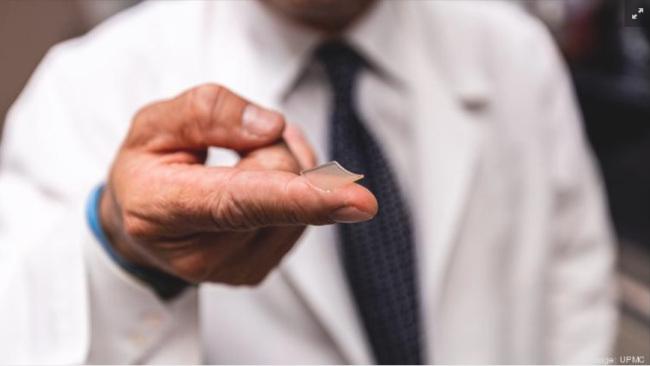RACE FOR A VACCINE: IS THIS PATCH THE BEST HOPE?
Will this be the winner in the race for a vaccine?: "Researchers from the University of Pittsburgh School of Medicine have developed a potential vaccine administered by a fingertip-sized patch to neutralize the novel coronavirus SARS-CoV-2 that causes COVID-19." The hitch: like all potential vaccines, it's probably 12-18 months away.

Will this be the winner in the race for a coronavirus vaccine? The delivery system is brilliant:
Researchers from the University of Pittsburgh School of Medicine have developed a potential vaccine administered by a fingertip-sized patch to neutralize the novel coronavirus SARS-CoV-2 that causes COVID-19...
PittCoVacc has been tested already in mice by Pitt scientists and created antibodies against SARS-CoV-2 within two weeks of delivery by a microneedle prick... And while long-term studies haven't been possible yet due to the speed of the pandemic, the study suggests antibody levels could be sufficient to squelch the virus for at least a year.
The hitch:
The testing phase would take at least a year and maybe more.
How it works:
PittCoVacc works essentially the way flu shots do, using viral proteins that are made in the lab to build immunity. It's built on previous work Pitt has done for previous SARS viruses, which are related to the current SARS-CoV-2. It differs from an mRNA vaccine made by Moderna that began clinical trials in Seattle. Pitt said it can be mass produced and be stored at room temperature until use.
"For most vaccines, you don't need to address scalability to begin with," said Dr. Andrea Gambotto, an assistant professor of surgery at the University of Pittsburgh and a co-senior author on the study. "But when you try to develop a vaccine quickly against a pandemic that's the first requirement."
Pitt has also used a high-tech delivery system, a microneedle array, that includes a Band-Aid-type patch with 400 small needles that put the vaccine into the skin. The needles dissolve into the skin.
Here's the scientific paper describing in detail how the patch works on the virus.
Safe vaccines that rapidly induce potent and long-lasting virus-specific immune responses against these infectious agents are urgently needed. The coronavirus spike (S) protein, a characteristic structural component of the viral envelope, is considered a key target for vaccines for the prevention of coronavirus infection.
Methods: We first generated codon optimized MERS-S1 subunit vaccines fused with a foldon trimerization domain to mimic the native viral structure. In variant constructs, we engineered immune stimulants (RS09 or flagellin, as TLR4 or TLR5 agonists, respectively) into this trimeric design. We comprehensively tested the pre-clinical immunogenicity of MERS-CoV vaccines in mice when delivered subcutaneously by traditional needle injection, or intracutaneously by dissolving microneedle arrays (MNAs) by evaluating virus specific IgG antibodies in the serum of vaccinated mice by ELISA and using virus neutralization assays. Driven by the urgent need for COVID-19 vaccines, we utilized this strategy to rapidly develop MNA SARS-CoV-2 subunit vaccines and tested their pre-clinical immunogenicity in vivo by exploiting our substantial experience with MNA MERS-CoV vaccines.Findings: Here we describe the development of MNA delivered MERS-CoV vaccines and their pre-clinical immunogenicity. Specifically, MNA delivered MERS-S1 subunit vaccines elicited strong and long-lasting antigen-specific antibody responses. Building on our ongoing efforts to develop MERS-CoV vaccines, promising immunogenicity of MNA-delivered MERS-CoV vaccines, and our experience with MNA fabrication and delivery, including clinical trials,we rapidly designed and produced clinically-translatable MNA SARS-CoV-2 subunit vaccines within 4 weeks of the identification of the SARS-CoV-2 S1 sequence. Most importantly, these MNA delivered SARS-CoV-2 S1 subunit vaccines elicited potent antigen-specific antibody responses that were evident beginning 2 weeks after immunization.

